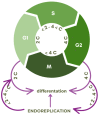Endoreplication-Why Are We Not Using Its Full Application Potential?
- PMID: 37511616
- PMCID: PMC10380914
- DOI: 10.3390/ijms241411859
Endoreplication-Why Are We Not Using Its Full Application Potential?
Abstract
Endoreplication-a process that is common in plants and also accompanies changes in the development of animal organisms-has been seen from a new perspective in recent years. In the paper, we not only shed light on this view, but we would also like to promote an understanding of the application potential of this phenomenon in plant cultivation. Endoreplication is a pathway for cell development, slightly different from the classical somatic cell cycle, which ends with mitosis. Since many rounds of DNA synthesis take place within its course, endoreplication is a kind of evolutionary compensation for the relatively small amount of genetic material that plants possess. It allows for its multiplication and active use through transcription and translation. The presence of endoreplication in plants has many positive consequences. In this case, repeatedly produced copies of genes, through the corresponding transcripts, help the plant acquire the favorable properties for which proteins are responsible directly or indirectly. These include features that are desirable in terms of cultivation and marketing: a greater saturation of fruit and flower colors, a stronger aroma, a sweeter fruit taste, an accumulation of nutrients, an increased resistance to biotic and abiotic stress, superior tolerance to adverse environmental conditions, and faster organ growth (and consequently the faster growth of the whole plant and its biomass). The two last features are related to the nuclear-cytoplasmic ratio-the greater the content of DNA in the nucleus, the higher the volume of cytoplasm, and thus the larger the cell size. Endoreplication not only allows cells to reach larger sizes but also to save the materials used to build organelles, which are then passed on to daughter cells after division, thus ending the classic cell cycle. However, the content of genetic material in the cell nucleus determines the number of corresponding organelles. The article also draws attention to the potential practical applications of the phenomenon and the factors currently limiting its use.
Keywords: benefits of polyploid plants; endocycles; endoreplication; polyploid plants; polyploids.
Conflict of interest statement
The authors declare no conflict of interest.
Figures




Similar articles
-
Molecular control and function of endoreplication in development and physiology.Trends Plant Sci. 2011 Nov;16(11):624-34. doi: 10.1016/j.tplants.2011.07.001. Epub 2011 Sep 1. Trends Plant Sci. 2011. PMID: 21889902 Review.
-
A Cyclin A-Myb-MuvB-Aurora B network regulates the choice between mitotic cycles and polyploid endoreplication cycles.PLoS Genet. 2019 Jul 10;15(7):e1008253. doi: 10.1371/journal.pgen.1008253. eCollection 2019 Jul. PLoS Genet. 2019. PMID: 31291240 Free PMC article.
-
Endoreplication - a means to an end in cell growth and stress response.Curr Opin Plant Biol. 2020 Apr;54:85-92. doi: 10.1016/j.pbi.2020.02.006. Epub 2020 Mar 24. Curr Opin Plant Biol. 2020. PMID: 32217456 Review.
-
Cytokinins promote onset of endoreplication by controlling cell cycle machinery.Plant Signal Behav. 2014;9(8):e29396. doi: 10.4161/psb.29396. Plant Signal Behav. 2014. PMID: 25763620 Free PMC article.
-
The Enigma of Progressively Partial Endoreplication: New Insights Provided by Flow Cytometry and Next-Generation Sequencing.Genome Biol Evol. 2016 Jul 2;8(6):1996-2005. doi: 10.1093/gbe/evw141. Genome Biol Evol. 2016. PMID: 27324917 Free PMC article.
Cited by
-
The SIAMESE family of cell-cycle inhibitors in the response of plants to environmental stresses.Front Plant Sci. 2024 Feb 16;15:1362460. doi: 10.3389/fpls.2024.1362460. eCollection 2024. Front Plant Sci. 2024. PMID: 38434440 Free PMC article. Review.
References
-
- Boudolf V., Vlieghe K., Beemster G.T., Magyar Z., Acosta J.A.T., Maes S., Van Der Schueren E., Inzé D., De Veylder L. The Plant-Specific Cyclin-Dependent Kinase CDKB1;1 and Transcription Factor E2Fa-DPa Control the Balance of Mitotically Dividing and Endoreduplicating Cells in Arabidopsis. Plant Cell. 2004;16:2683–2692. doi: 10.1105/tpc.104.024398. - DOI - PMC - PubMed
Publication types
MeSH terms
Substances
Grants and funding
LinkOut - more resources
Full Text Sources

